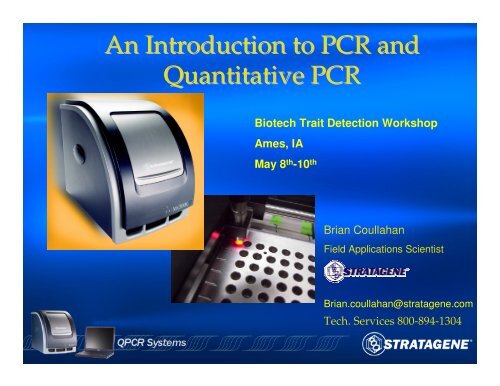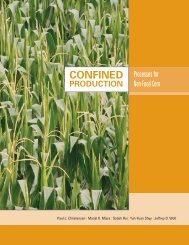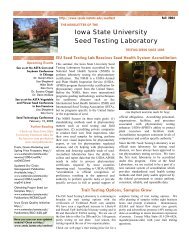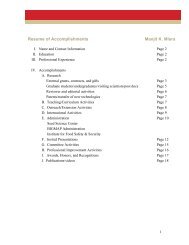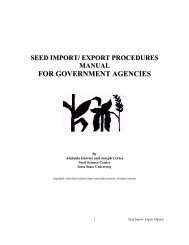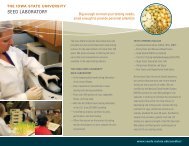An Introduction to PCR and Quantitative PCR
An Introduction to PCR and Quantitative PCR
An Introduction to PCR and Quantitative PCR
- No tags were found...
You also want an ePaper? Increase the reach of your titles
YUMPU automatically turns print PDFs into web optimized ePapers that Google loves.
<strong>An</strong> <strong>Introduction</strong> <strong>to</strong> <strong>PCR</strong> <strong>and</strong><br />
<strong>Quantitative</strong> <strong>PCR</strong><br />
Biotech Trait Detection Workshop<br />
Ames, IA<br />
May 8 th -10 th<br />
Brian Coullahan<br />
Field Applications Scientist<br />
Brian.coullahan@stratagene.com<br />
Tech. Services 800-894-1304
Presentation Outline<br />
• Review <strong>PCR</strong> fundamentals<br />
Current systems used for GMO testing<br />
• <strong>Introduction</strong> <strong>to</strong> <strong>Quantitative</strong> <strong>PCR</strong><br />
<strong>Quantitative</strong> methods for GMO testing
Polymerase Chain Reaction<br />
Introduced <strong>to</strong> the Scientific community in 1983,<br />
<strong>PCR</strong> allows for exponential amplification of<br />
sequence-specific targets in a DNA molecule<br />
<strong>PCR</strong> has allowed for simplification of techniques<br />
such as cloning, target detection, sequencing,<br />
etc…
Polymerase<br />
Chain<br />
Reaction
Polymerase<br />
Chain<br />
Reaction
Components in a <strong>PCR</strong><br />
•Template DNA<br />
•dNTPs<br />
•Forward <strong>and</strong> reverse primers<br />
•Thermal-stable DNA polymerase<br />
•Buffer (tris, KCl, Mg 2+ , etc..)
Phases of <strong>PCR</strong><br />
Plateau phase<br />
[DNA]<br />
linear phase<br />
Exponential phase<br />
Cycle #
Detection of Insertion using <strong>PCR</strong><br />
insertion<br />
gDNA<br />
Foreign DNA is inserted in<strong>to</strong> genome of organism
Detection of Insertion using <strong>PCR</strong><br />
gDNA<br />
30+ cycles <strong>to</strong> reach plateau phase
Gel-based <strong>An</strong>alysis<br />
Sample<br />
1 2 3 4 5 6<br />
Insert-specific target<br />
Control from WT gDNA<br />
Insert was detected in<br />
sample1 <strong>and</strong> sample3<br />
At what level<br />
Low range<br />
of detection
<strong>Quantitative</strong> Real Time <strong>PCR</strong><br />
• Definition: Assay that moni<strong>to</strong>rs the<br />
accumulation of a DNA product from a<br />
<strong>PCR</strong> reaction.<br />
– Quantitate the initial number of copies of a<br />
particular DNA in a sample.<br />
– Benefits from improved sensitivity,<br />
reproducibility, dynamic range, throughput,<br />
cost.
Q<strong>PCR</strong> Amplification Plot<br />
Fluorescence (R)<br />
Baseline<br />
Amplification<br />
Threshold<br />
Ct<br />
Cycle #<br />
C t = Fractional <strong>PCR</strong> cycle number at which<br />
the fluorescence intensity crosses the<br />
established threshold line.
<strong>PCR</strong> Molecular Mechanism<br />
• Exponential amplification of the original DNA<br />
sequence (template) <strong>to</strong> create copies of part of the<br />
sequence (amplicon)<br />
X n =X 0 (1+E) n<br />
X n =X 0 2 n<br />
X = DNA concentration<br />
X 0 = Starting DNA concentration<br />
X n = DNA concentration X at = cycle DNA concentration<br />
n<br />
E = Efficiency of <strong>PCR</strong> reaction X 0 = : 0 Starting ≤ E ≥ 1DNA concentration<br />
X n = DNA concentration at cycle n
<strong>PCR</strong> Molecular Mechanism<br />
• Exponential amplification of the original DNA<br />
sequence (template) <strong>to</strong> create copies of part of the<br />
sequence (amplicon)<br />
X n =X 0 (1+E) n<br />
X = DNA concentration<br />
X 0 = Starting DNA concentration<br />
X n = DNA concentration at cycle n<br />
E = Efficiency of <strong>PCR</strong> reaction, 0-1
<strong>Quantitative</strong> <strong>PCR</strong><br />
[DNA]<br />
Threshold<br />
<br />
Ct<br />
<br />
Ct<br />
15<br />
Cycle #
St<strong>and</strong>ard Curve<br />
Efficiency= 99.5%
Fluorescence Detection<br />
light<br />
light<br />
Absorption<br />
Emission<br />
Wavelength
<strong>Quantitative</strong> <strong>PCR</strong> Chemistries<br />
dsDNA Binding<br />
Probe Based<br />
Detection<br />
• SYBR Green I TM<br />
• TaqMan ®<br />
• Molecular Beacons<br />
• Lux ® primers<br />
• Hybridization probes<br />
• Scorpions TM<br />
• Amplifluor ® probes<br />
• FRET
SYBR Green I<br />
DNA + free dye<br />
(weak fluorophore)<br />
Binds minor groove dsDNA<br />
(fluorescence ↑1,000x)
SYBR Green I Thermal Profile<br />
Activation Amplification Dissociation
SYBR Green I Detection
End-Point Melt Curve Detection<br />
Control- WT gDNA
End-Point Melt Curve Detection<br />
Control- WT gDNA<br />
Amplicon from insert
TaqMan ® Probes<br />
<br />
<br />
<br />
<br />
<br />
!<br />
<br />
<br />
<br />
"<br />
<br />
!<br />
!<br />
"<br />
"# $ <br />
%%&
4-Fluor Multiplex-St<strong>and</strong>ard Curves
4-Fluor Multiplex-St<strong>and</strong>ard Curves<br />
%E Cy5=95.3%<br />
%E Rox=98.9%<br />
%E Hex=101.3%<br />
%E Fam=91.7%
Q<strong>PCR</strong> for GMO Detection<br />
•Dilution series of GMO product in<br />
required dynamic range<br />
st<strong>and</strong>ard 1<br />
st<strong>and</strong>ard 2<br />
% WT<br />
99.04<br />
99.52<br />
% GMO<br />
0.96<br />
0.48<br />
st<strong>and</strong>ard 3<br />
99.76<br />
0.24<br />
•St<strong>and</strong>ards diluted in WT gDNA<br />
matrix<br />
st<strong>and</strong>ard 4<br />
st<strong>and</strong>ard 5<br />
st<strong>and</strong>ard 6<br />
99.88<br />
99.94<br />
99.97<br />
0.12<br />
0.06<br />
0.03<br />
NTC<br />
100<br />
0
Q<strong>PCR</strong> for GMO Detection<br />
WT specific amplicon<br />
GMO specific amplicon<br />
WT control<br />
.96<br />
.48<br />
.24<br />
0.12 0.03<br />
0.06<br />
NTC<br />
% of <strong>to</strong>tal gDNA
Q<strong>PCR</strong> for GMO Detection<br />
< lowest dilution in curve<br />
Ct<br />
Accurate quantitation of<br />
% contamination<br />
> Highest dilution in curve<br />
Log quantity
St<strong>and</strong>ard Curve <strong>An</strong>alysis
St<strong>and</strong>ard Curve
Results from St<strong>and</strong>ard Curve
Conclusion<br />
•<strong>PCR</strong> is a invaluable <strong>to</strong>ol enabling the GMO environment<br />
<strong>to</strong> reach levels of sensitivity unable <strong>to</strong> be obtained from<br />
other methods<br />
•<strong>Quantitative</strong> <strong>PCR</strong> is the next technological step in<br />
accurate detection <strong>and</strong> quantification of GMO testing in<br />
food materials


